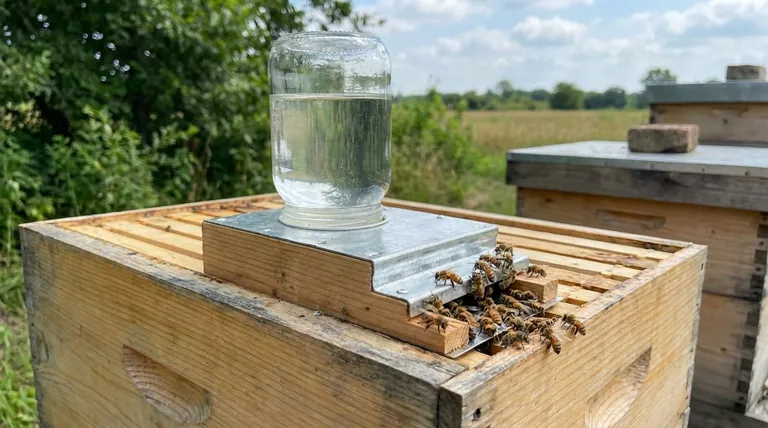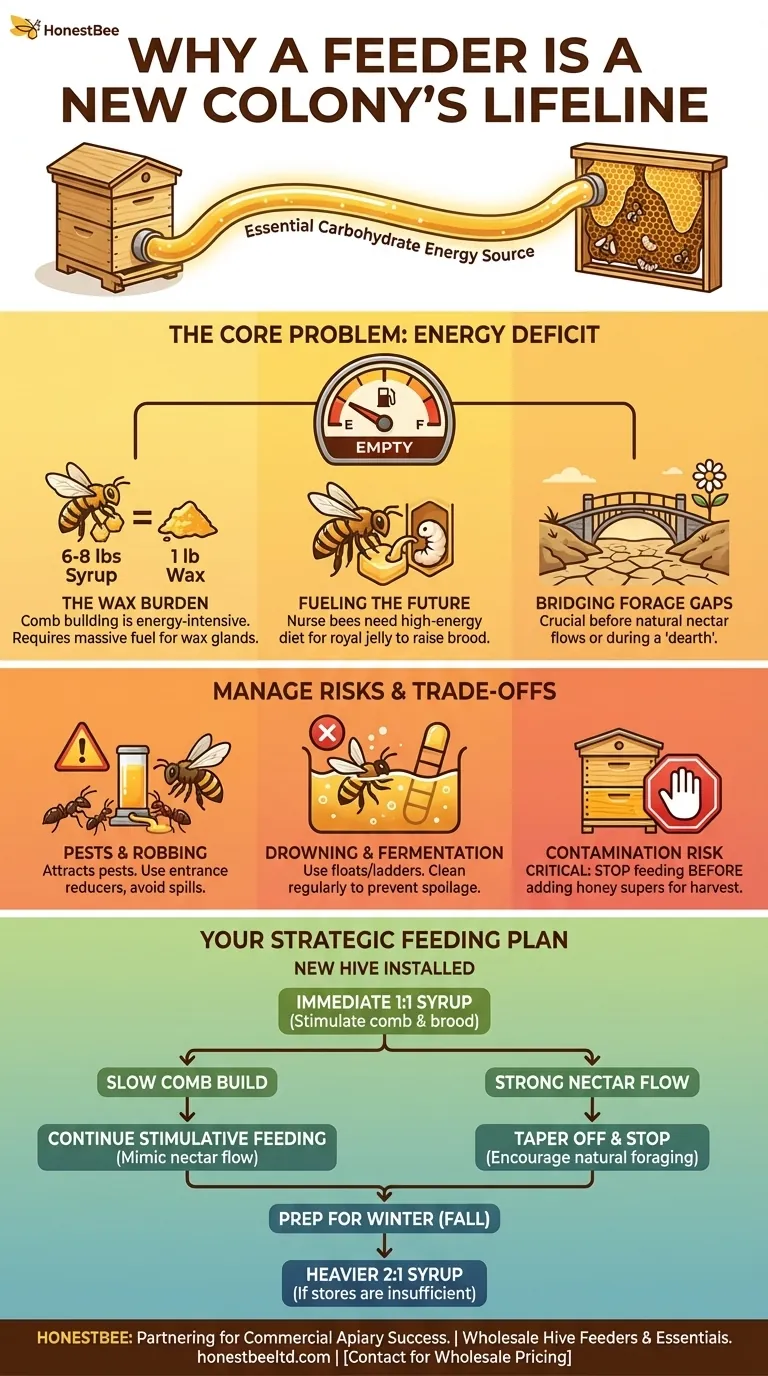In short, a feeder is a new colony's lifeline. For a newly established hive, a feeder provides the essential carbohydrate energy needed to perform the two most critical and energy-intensive tasks: building wax comb and raising the first generation of brood. Without this supplemental fuel, a new colony can quickly falter, especially if natural nectar sources are not yet abundant.
A hive feeder is not simply a tool to prevent starvation. It is a strategic instrument used to simulate a natural nectar flow, stimulating the queen to lay eggs and motivating the workers to rapidly build the wax infrastructure the colony needs to become self-sufficient.

The Core Problem: A New Colony's Energy Deficit
When you install a package of bees or a nuc, you are placing them in an empty or partially built house. They arrive with a significant energy deficit and an enormous amount of work to do before they can sustain themselves.
The Burden of Building a Home
Drawing beeswax comb is one of the most energy-intensive activities bees undertake. Worker bees must consume large amounts of nectar or sugar syrup to activate their wax glands.
The accepted ratio is that bees consume 6 to 8 pounds of honey or syrup to produce just 1 pound of wax. A new colony must build out multiple frames of this comb from scratch to store food and for the queen to lay eggs.
Fueling the Next Generation
A new colony's survival depends on rapidly increasing its population. The queen's primary job is to start laying eggs immediately, but this is useless without the resources to raise the resulting larvae.
Nurse bees require a constant, high-energy diet to produce the royal jelly and bee bread needed to feed the developing brood. A lack of incoming food will cause the colony to slow or even stop brood rearing, stalling its growth at the most vulnerable time.
When Natural Forage Isn't Enough
Beekeepers often install new colonies in early spring, strategically timed to build up the population before the primary nectar flow begins.
This timing means the bees may not have access to sufficient natural forage. A feeder bridges this gap, ensuring the colony doesn't just survive but actively grows during this critical pre-bloom period. This is also crucial during a "dearth," a sudden period of poor weather or a gap between blooming seasons.
Understanding the Trade-offs and Risks
While essential, feeding is not without its risks. Proper management is key to ensuring the feeder helps, rather than harms, your new hive.
The Risk of Attracting Pests
The smell of sugar syrup is a powerful attractant for pests. Ants, yellow jackets, and even bees from other hives ("robber bees") can be drawn to the feeder.
Robbing, where a stronger hive attacks a weaker one to steal its stores, can decimate a new colony in a matter of hours. To mitigate this, use an entrance reducer to make the hive easier for your bees to defend and ensure there are no drips or spills around the hive.
The Danger of Drowning and Fermentation
Bees can easily drown in open feeders. Always provide a textured surface, floats, or a "ladder" (like a piece of hardware cloth) to ensure bees can safely access the syrup without falling in.
Syrup, especially thin 1:1 syrup, can also ferment in warm weather. Fermented syrup can be harmful to bees, so it's important to only provide as much as the bees will consume in a few days and to clean your feeders regularly.
When to Stop Feeding
This is the most critical rule: you must stop feeding before adding honey supers that you intend to harvest for human consumption.
Continuing to feed will result in the bees storing sugar syrup in the honey frames, contaminating the final product. The goal is to use feeding to get the colony strong enough to forage for itself, then let them gather natural nectar for their surplus honey stores. Stop feeding when the bees are no longer eagerly taking the syrup and a strong nectar flow has begun.
Your Feeding Strategy for a New Hive
Your approach should adapt to the colony's progress and the environment.
- If you just installed a new package or nuc: Begin feeding a 1:1 sugar syrup (by weight) immediately to provide the energy for comb construction and brood rearing.
- If your bees are slow to draw out new comb: Continue this "stimulative" feeding to mimic a nectar flow and encourage rapid wax production.
- If a strong nectar flow is underway and bees are building comb: Taper off and stop feeding to encourage them to forage for natural nectar and prevent contaminating future honey stores.
- If you are preparing an established hive for winter: You may feed a heavier 2:1 syrup (sugar to water) in the fall if their natural honey stores are insufficient.
Strategic feeding is one of the most effective actions a beekeeper can take to ensure a young colony survives and thrives.
Summary Table:
| Purpose of Feeding | Key Benefit |
|---|---|
| Comb Building | Fuels wax production (6-8 lbs syrup for 1 lb wax) |
| Brood Rearing | Provides energy for nurse bees to raise the next generation |
| Bridging Forage Gaps | Ensures colony growth before/during natural nectar dearths |
Ensure your new colonies thrive from day one. Proper feeding is a cornerstone of successful beekeeping. At HONESTBEE, we supply commercial apiaries and beekeeping equipment distributors with the durable, efficient hive feeders and essential supplies needed to support strong colony establishment. Let our wholesale-focused expertise help your operation succeed.
Contact our team today to discuss your hive feeder needs and wholesale pricing.
Visual Guide

Related Products
- Boardman Entrance Bee Feeder Durable Galvanized Steel and Wood Construction for Beekeeping
- Professional Hive Front Entrance Bee Feeder
- HONESTBEE Entrance Bee Feeder Professional Hive Nutrition Solution for Beekeeping
- HONESTBEE Round Hive Top Bee Feeder for Syrup
- Classic Boardman Entrance Bee Feeder Hive Front Feeding Solution
People Also Ask
- How does an entrance feeder work? A Guide to Its Simple Mechanics and Risks
- What types of bee feeders are available for beginners? Start with the Simple Entrance Feeder
- What is an entrance feeder and how is it used? Avoid the Critical Risk of Robbing
- How does the entrance feeder method work? A Guide to Simple But Risky Hive Feeding
- What is an entrance feeder? A Guide to Its Simple Design and High Robbing Risk



















